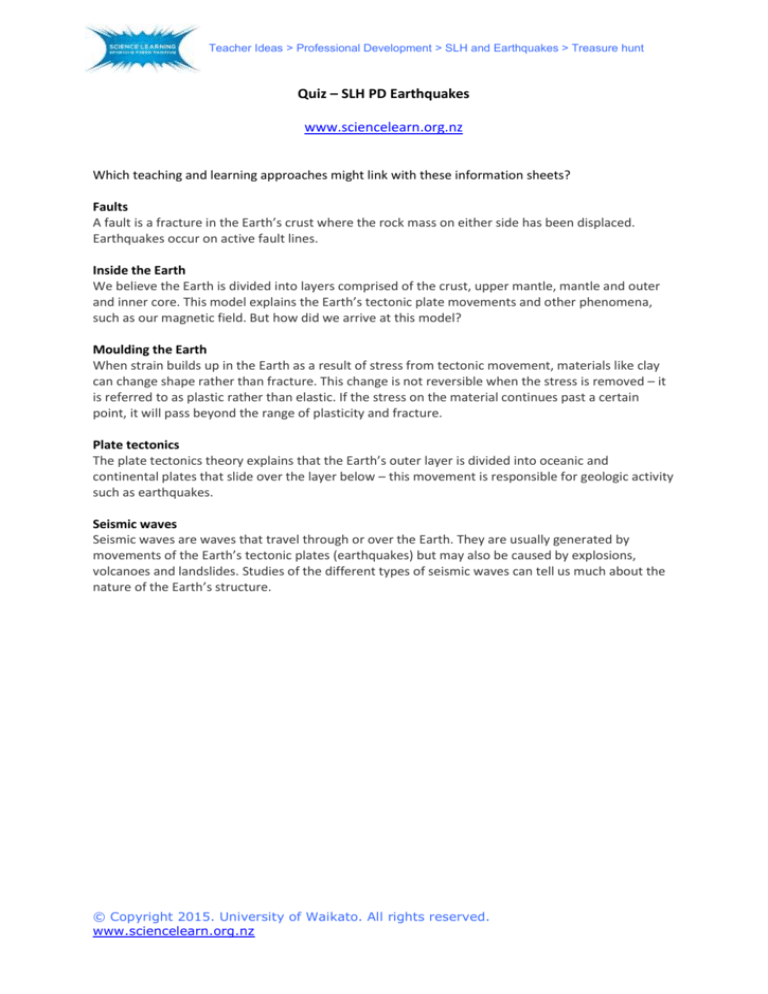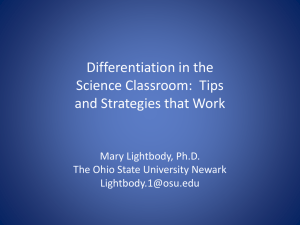
Teacher Ideas > Professional Development > SLH and Earthquakes > Treasure hunt
and t
Quiz – SLH PD Earthquakes
www.sciencelearn.org.nz
Which teaching and learning approaches might link with these information sheets?
Faults
A fault is a fracture in the Earth’s crust where the rock mass on either side has been displaced.
Earthquakes occur on active fault lines.
Inside the Earth
We believe the Earth is divided into layers comprised of the crust, upper mantle, mantle and outer
and inner core. This model explains the Earth’s tectonic plate movements and other phenomena,
such as our magnetic field. But how did we arrive at this model?
Moulding the Earth
When strain builds up in the Earth as a result of stress from tectonic movement, materials like clay
can change shape rather than fracture. This change is not reversible when the stress is removed – it
is referred to as plastic rather than elastic. If the stress on the material continues past a certain
point, it will pass beyond the range of plasticity and fracture.
Plate tectonics
The plate tectonics theory explains that the Earth’s outer layer is divided into oceanic and
continental plates that slide over the layer below – this movement is responsible for geologic activity
such as earthquakes.
Seismic waves
Seismic waves are waves that travel through or over the Earth. They are usually generated by
movements of the Earth’s tectonic plates (earthquakes) but may also be caused by explosions,
volcanoes and landslides. Studies of the different types of seismic waves can tell us much about the
nature of the Earth’s structure.
© Copyright 2015. University of Waikato. All rights reserved.
www.sciencelearn.org.nz
Teacher Ideas > Professional Development > SLH and Earthquakes > Treasure hunt
and t
Treasure hunt – SLH PD Earthquakes – answers
Which teaching and learning approaches might link with these information sheets?
Earthquakes New Zealand
This teacher resource introduces a series of activities to help students understand about earthquakes
in New Zealand, including why we get them and how we measure them.
World of quakes
In this activity, students take on the roles of seismologists and vulcanologists, using maps to look for
patterns in the worldwide distribution of earthquakes and volcanoes.
Plates and quakes
In this activity, students take on the roles of seismologists, vulcanologists and geographers, using
maps to look for patterns in the worldwide distribution of earthquakes, volcanoes and topographic
features.
Shaky New Zealand
In this activity, students use maps to plot a graph of earthquakes under New Zealand to show the
shape of the North Island subduction zone and compare this to the distribution of earthquakes in the
South Island.
New Zealand plate boundary models
In this activity, students make and/or observe two 3D moving models of the different tectonic plate
boundaries under the North and South Islands representing the North Island subduction zone and the
South Island Alpine Fault.
Earthquake location
In this activity, students are introduced to some of the methods scientists use to record earthquakes.
They obtain data from tables and graphs, carry out simple calculations and draw results on a map.
Earthquake intensity
In this activity, students study damage descriptions from earthquakes and allocate a Modified
Mercalli Intensity (MMI) number.
Earthquakes past and future
In this activity, students use data on historical earthquakes to identify when and where they occurred
and make predictions about future earthquakes.
Best base isolator
In this activity, students use a physical model to investigate the effectiveness of different properties
for base isolators.
Something creepy is happening
In this activity, students explore tectonic movements called slow slips. They plot and interpret a
graph using data from an actual event in New Zealand.
Unit plan: Earthquakes
This teacher resource along with the Science Learning Hub context Earthquakes is designed to help
primary school teachers improve students’ understanding about what causes earthquakes and how
we can protect ourselves.
© Copyright 2015. University of Waikato. All rights reserved.
www.sciencelearn.org.nz










